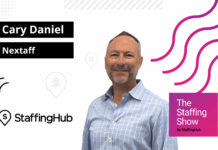
Key takeaways:
- Independent work satisfaction surges: Nearly 75% of independents report higher fulfillment than traditional employees, citing autonomy, values alignment, and career control.
- High-earning independents on the rise: 5.6M professionals now make six figures as independents (up from 1.9M in 2011), shifting premium talent away from traditional staffing channels.
- Tech and AI accelerate disruption: Online platforms and AI tools boost productivity and confidence, pressuring staffing firms to rethink their value proposition and adapt business models.
Nearly three-quarters of independent professionals report higher satisfaction than traditional employees, according to MBO Partners’ 2025 State of Independence report. And they’re earning more, too — over 5.6 million independent professionals now earn six-figure incomes, nearly tripling from 1.9 million in 2011.
Independent professionals report feeling more authentic, aligned with their values, and in control of their careers. When professionals experience greater fulfillment working independently, staffing firms face selling candidates on opportunities that may represent lifestyle downgrades.
The network effect challenge
Over half of independent professionals report that more of their friends and family are choosing independent work. Among high earners, this percentage jumps to nearly two-thirds. This creates a compounding challenge — as independent work becomes normalized within professional circles, the talent pool for traditional placements shrinks.
The implications extend to client relationships. As talented professionals experience independent work’s autonomy, client expectations around flexibility and alternative workforce models evolve. Staffing firms that haven’t adapted risk losing both talent and clients.
Technology reshapes competition
Nearly half of independent professionals now use online platforms as their primary work-finding method, compared to 14% a decade ago. These professionals maintain active profiles on nearly four different platforms, diversifying opportunities and reducing dependence on traditional staffing relationships.
Artificial intelligence adoption accelerates this shift. Three-quarters of independent professionals now use AI tools regularly, reporting an average time savings of nine hours weekly. This productivity boost increases their effective hourly rates and confidence levels, creating pricing pressure on traditional staffing models.
What this means for staffing leaders
Defensively, staffing firms must address the retention challenges created when traditional employees increasingly view independent work as a viable and attractive alternative.
The research shows that over one-third of traditional employees now maintain side gigs, with many specifically offering freelance or consulting services to businesses. This represents a pipeline of professionals actively building independent capabilities while still nominally employed. Staffing firms that recognize this trend early can position themselves as partners in these transitions rather than obstacles to them.
Offensively, the growth in high-earning independent professionals represents a significant opportunity for staffing firms willing to adapt their business models. These professionals seek partners who can help them navigate complex client relationships, manage project scope, and access opportunities that align with their expertise and values.
The key differentiator lies in understanding what motivates today’s top independent talent. Unlike traditional job seekers focused primarily on compensation and benefits, independent professionals prioritize autonomy, purpose alignment, and meaningful work. They seek partners who respect their expertise and support their professional goals rather than simply filling requisitions.





